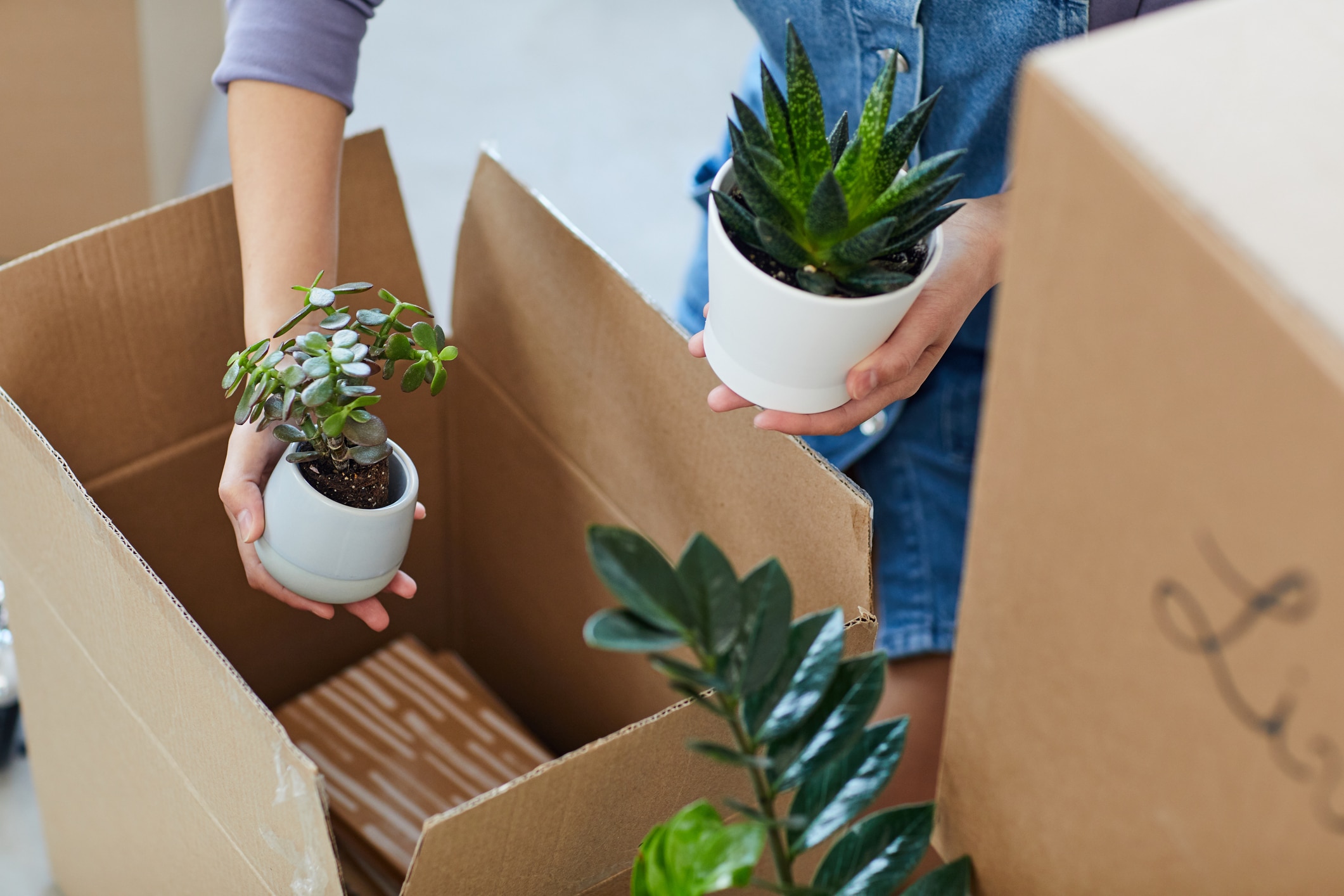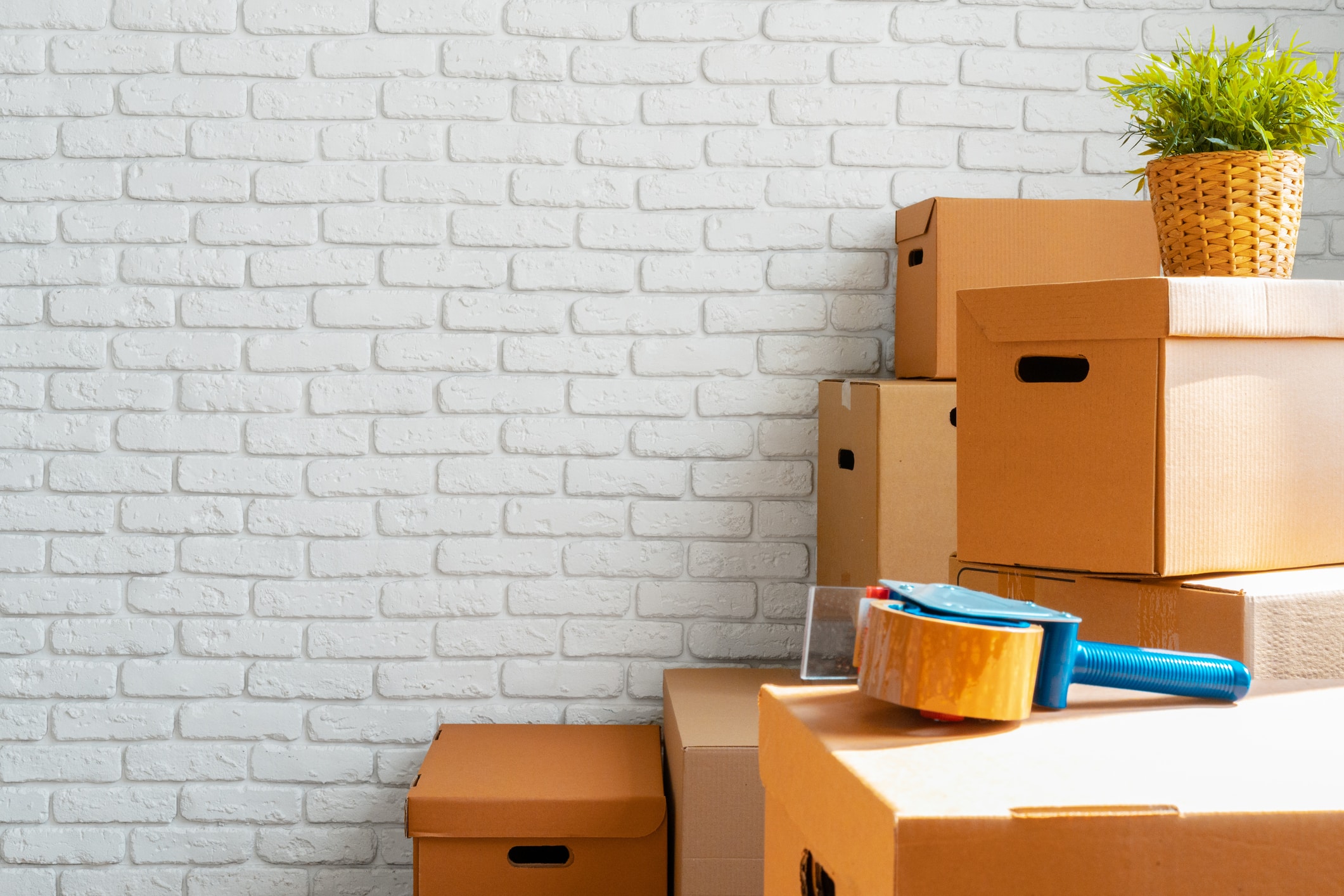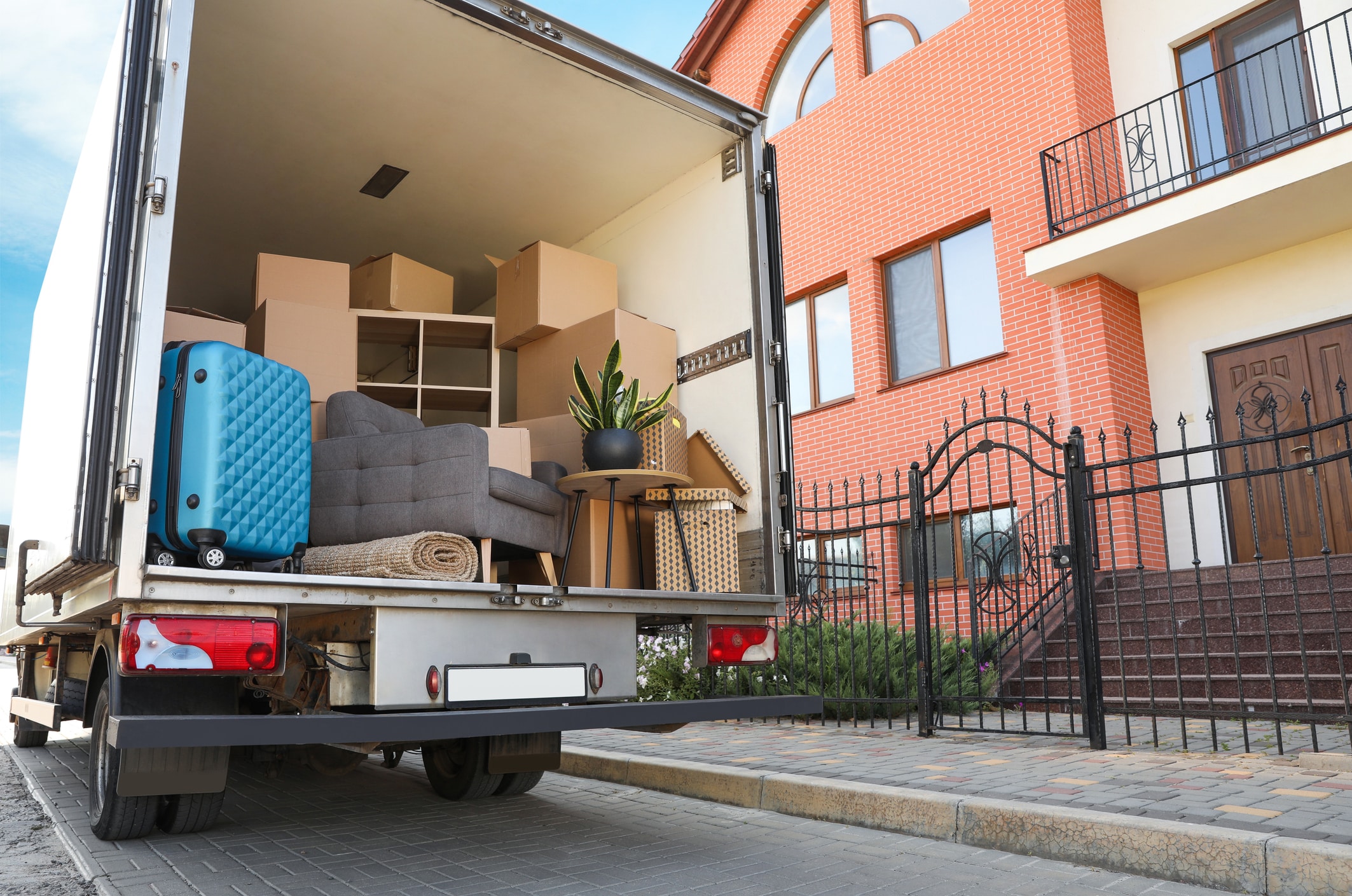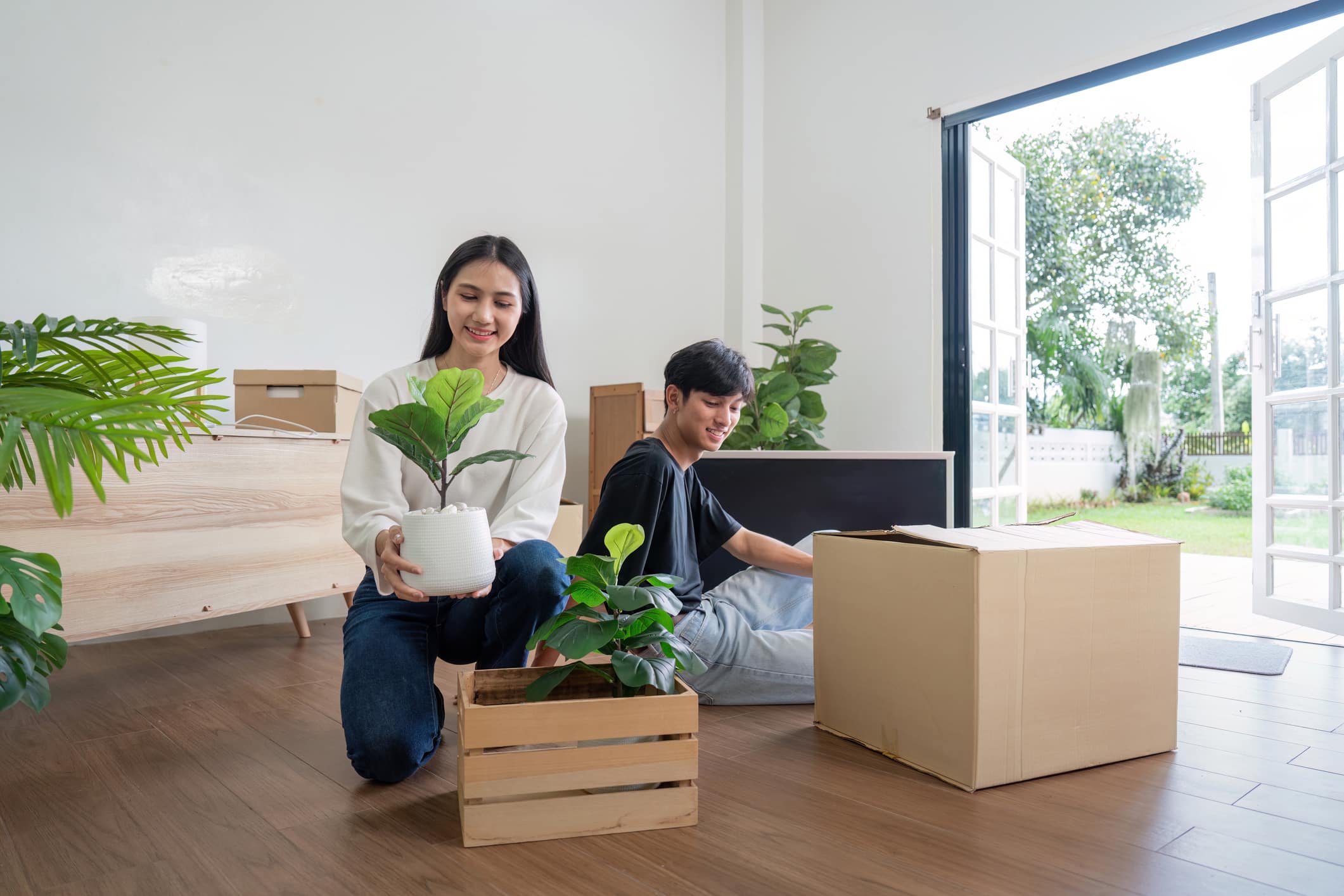(Updated March 18, 2025)
As a plant parent, the thought of leaving your plants behind when you move can be tough — but sorting out how to transport those plants to your new home may feel just as hard. After all, how do you move a plant without killing it?
Fortunately, it’s not as impossible as you might think. In this guide, we’ll cover everything you need to know about moving plants, from how to pack your plants to how to transport them safely. We have a lot to cover, so let’s jump right in.
How to Prepare for Moving Plants
The best thing you can do for your plants is to prepare them for your move ahead of time. Here are the steps you should take (and when to take them) to ensure your plants are ready for moving day:

4 Weeks Out: Decide Which Plants To Bring
While the beauty or sentimental value of certain plants may sway your decision on which plants to take to your new home and which to leave behind, there are other important factors to consider, too.
The new climate
The key question: When moving plants cross-country, will your plants adjust to the new climate?
Keep in mind that elevation, humidity, and temperature changes can all affect a plant’s chance of survival. If you’re planning to move tropical plants from Florida to Utah, for instance, they may not survive the winter. If you’re not sure what to expect from your new climate, refer to the USDA’s Plant Hardiness Zone Map for guidance.
Travel conditions
Both the length of your trip and the weather conditions will have a significant impact on how you move your plants — and whether you should.
If you can choose the timing of your move, note that most plants will travel best during temperate seasons like spring and fall. If you don’t have control over when you move, it may be time to let your aging and struggling plants go.
Agricultural restrictions
To reduce the risk of spreading disease or carrying pests across state lines, the USDA created a list of restricted plants that require a permit for any interstate move. Each state also enforces its own regulations for transporting plants across state lines. If you’re moving to a new state, make sure to check out your state-specific plant restrictions.
3 Weeks Out: Repot Your Plants
Once you’ve decided which plants are coming with you, repot them a few weeks out so they have time to adjust before the move.
Use Travel-Friendly Containers
Clear plastic pots are usually the way to go when preparing your plants for travel. They’re lighter and more durable than clay or ceramic pots, which makes them easier to haul and less likely to break in transit.
Prune and Check for Pests
Repotting is also a great time to do some plant maintenance, like checking for pests and pruning back leaves and stems. This will not only prevent your plants from getting sick but also make them easier to handle during the move.
2 Weeks Out and Forward: Fortify Your Plants
After you’ve repotted and pruned your plants, reinforce them with regular feedings and watering in the days leading up to your move. Water your plants one to two days before your move so they’re well-hydrated for moving day.

How to Pack Plants for Moving
You wouldn’t pack fragile items by throwing them in a box without padding to cushion and secure them, would you? Like dishware or your favorite piece of art, plants need to be packed with care to ensure they survive your move.
When to Pack Your Plants
Wait to pack your plants until either the night before or the morning of your move. That said, make sure you’re prepared with the right supplies beforehand to set yourself (and your plants) up for success.
Supplies for Packing Your Plants
While the supplies you need will vary depending on the plants you own and how you plan to move them, here’s a list of items to have on hand:
Boxes (of various sizes)
Twine
Scissors
Tape
Tissue paper and/or newspaper
Oversized plastic bags
Old bed sheets
Towels and rags
How to Pack Smaller House Plants
Wrap the base of each plant with plastic wrap to prevent water or soil from spilling.
Gently wrap each plant in newspaper or tissue paper to protect the leaves and stems.
Pack your plants snuggly in a box that’s taller than them and use excess tissue paper or rags to fill the gaps so they don’t shift during transport.
How to Pack a Larger House Plant
Remove the plant from its pot and wrap the roots in a damp towel. Then, gently place the plant in a large plastic bag.
If any stems or branches need extra support, secure them gently together with twine.
Pack the plant in a sturdy box and cushion the edges with extra paper or towels to secure it.
If the box is shorter than the height of the plant, gently place an oversized plastic bag or bed sheet over the top of the plant to protect its leaves and branches.
How to Pack Plant Clippings
Determine which plant you want to take clippings from.
Identify a stem of that plant that shows healthy growth (and no sign of disease or decay) and cut off 4–6 inches using pruning shears. Repeat for more clippings.
If you have time, let the plant clippings dry out for a couple of hours before packing — this can prevent premature rotting.
Wrap the base of each clipping with a damp paper towel, then cover in plastic wrap or a small plastic bag.
If you have multiple clippings, pack them together in a small box, using paper or rags to keep them from moving around.
How To Transport Plants When Moving

How To Transport Plants by Car
If you want to know how to move your plants cross-country without killing them, transporting them in your own car is likely your best option.
Why? It’s simple: When you have your plants with you, you can keep an eye on them and make real-time adjustments to keep them happy on the trip.
Make space in the cab of your car — not the trunk — for your plants.
Ensure your plants are wedged between other items so they don’t shift while the car is moving.
If you have a taller plant, cover the top of the plant in a plastic bag or old bed sheet so it doesn’t get damaged.
To prevent your plants from being exposed to direct sunlight, cover either your windows or the plants themselves with light blankets, towels, or newspapers.
Keep the temperature regulated in the car — turn on the A/C in the summer and the heat in the winter.
During pit stops, park in the shade and crack a window whenever you can.
If you’re planning a long-distance move, take your plants with you inside if you make an overnight stop.
How to Transport Plants by Plane
You can fly with houseplants in either checked bags or carry-on luggage, per the TSA.
Remove your plants from their pots (if applicable) and wrap the roots in damp paper towels and plastic wrap.
Lightly wrap the branches and leaves in tissue paper or newspaper for some extra protection.
If you’re taking your plants onto the airplane with you as a personal item, pack them securely together in either a small box or a tote with a stable base that can fit under the seat in front of you.
If you’re moving plants in a suitcase (as checked baggage or carry-on luggage), wrap each plant in a large plastic bag, then gently pack them in the suitcase with soft, lightweight items like clothing.
How to Transport Plants When Using a Moving Company
Due to interstate restrictions, many moving companies won’t move your plants for you. Contact your mover ahead of time to check if moving plants is a service they offer.
Pack your plants according to the instructions provided above, depending on their size and type.
If the plants are securely packed in boxes, label the boxes — e.g., “live plant,” “fragile,” “this side up” — so your movers know to take extra care with those items.
Ask your movers to load your plants last so you can access them quickly once you get to your final destination.
How to Ship Your Plants
You can ship plants through USPS, UPS, and FedEx. This is a great option if you’ll be hiring a full-service mover whose policy prohibits them from transporting plants on their truck.
Remove your plants from their pots and wrap the roots in damp paper towels and plastic wrap.
Wrap the branches and leaves in tissue paper or newspaper for extra protection.
Pack the plants in a box that is just slightly bigger than them. That way, they have room to breathe but won’t shift around during transport.
Label each box with stickers (like “fragile, “live plant,” “perishable,” and “this end up”) to avoid damage during shipment.
Select priority shipping — this will ensure your plants get to their final destination as quickly as possible.

How To Move Plants Into Your New Home
Do plants get stressed when moved? Unfortunately, yes. Plants don’t like change, so the strain from uprooting them and changing their environment may manifest in wilted leaves, discoloration, or stunted growth.
Like you, it may take some time for your plants to feel settled once they’ve arrived in your new home — but with the right care, they can bounce back in no time. Here are a few things to keep in mind to help them acclimate:
1) Unload and Unpack Your Plants
Once you’ve arrived at your new home, unpacking your plants should be your number one priority. Remove your plants from their boxes and other wrapping immediately — they’ll need the sunlight and fresh air.
Check to determine the impact of the move. If any stems or leaves are damaged or dead, carefully remove them.
2) Reacclimate Your Plants
Plants don’t like change, and after their journey to your new home, your plants will likely experience some degree of shock.
To minimize stress, decide where each plant will live and put it there as soon as you can. Refrain from moving your plants around for a couple of weeks to allow them time to get settled.
3) Refortify Your Plants
To help your plants thrive, get back into a routine. Make sure to water and feed them on a schedule, and continue to prune and inspect for pests and diseases regularly. With enough time and care, they’ll be back to normal before you know it.
Moving Plants (and Everything Else) Made Easier
Now that you have the packing and transport or your plants covered, it’s time to plan the rest of your move.
Our team of expert movers at Colonial Van Line is here to help you every step of the way, from packing and loading to transport and unloading. Get a free quote today!

